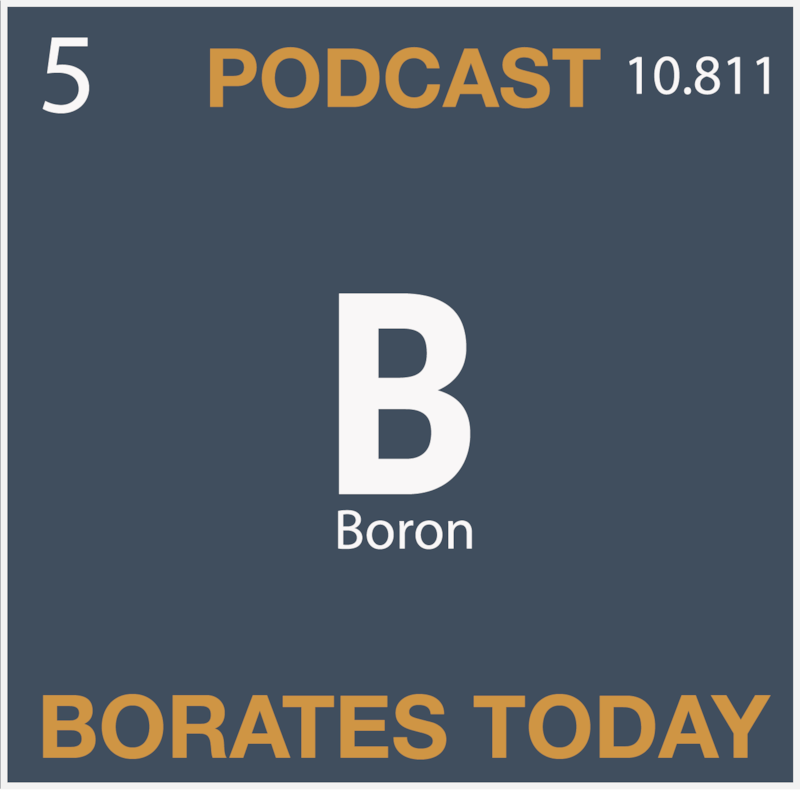
Shownotes
In today's podcast, we're going to look at boron-based polymers for EV storage.
Boron-based polymers such as BNNTs or boron nitride, nanotubes are two-dimensional nanomaterials with excellent properties for improving electric vehicle energy storage, given their high surface areas, large aspect ratios, and good thermal conductivity.
Transcripts
Welcome back to the Borates Today podcast.
Brendan:Each week we cover a topic that is relevant to the industry and timely.
Brendan:We cover the latest industry news.
Brendan:Who are the key players in the sector?
Brendan:What are the latest trends, driving demand and supply for boron.
Brendan:What is the science behind boron and who's doing valuable research into
Brendan:new boron applications and benefits?
Brendan:We look at how boron helps in advanced energy, in food security,
Brendan:and in providing nutrition.
Brendan:So don't forget to check out boron applications and benefits
Brendan:on our website borates.today.
Brendan:In today's podcast, we're going to look at boron-based polymers for EV storage.
Brendan:Boron-based polymers such as BNNTs or boron nitride, nanotubes are
Brendan:two-dimensional nanomaterials with excellent properties for improving
Brendan:electric vehicle energy storage, given their high surface areas, large aspect
Brendan:ratios, and good thermal conductivity.
Brendan:Today we examine the potential for use of BNNTs in electrical
Brendan:vehicle transmissions and batteries.
Brendan:Electric vehicle sales have been on an upward trend for years
Brendan:and projections show that this will continue into the future.
Brendan:In 2020, the global market for electric vehicles was valued
Brendan:at 246.7 billion US dollars.
Brendan:COVID 19 of course has had a massive and unprecedented worldwide impact but
Brendan:electric car sales are still seeing a steady increase in demand in all regions.
Brendan:According to a study, the global market growth was down by 9.7% in 2020
Brendan:compared to an average year on year growth from 2017 to 19 but during the
Brendan:future period, 21 to 28, the market is expected to bounce back at a CAGR
Brendan:of 24.3% from 287.36 billion in 2021.
Brendan:This large increase in compound annual growth rate is due to the
Brendan:growth and demand expected as a result of a return to pre pandemic levels
Brendan:once the coronavirus crisis is over.
Brendan:Let's have a closer look at BNNTs.
Brendan:Well, the question is how will boron nitride nanotubes support
Brendan:electric power and vehicles.
Brendan:One answer may be through introducing BNNTs into polymer, nano composites
Brendan:to improve electrical conduction.
Brendan:Polymer nano-composites incorporating BNNTs show enhanced dielectric properties
Brendan:due to synergistic effects of the nanoparticles and the host matrix.
Brendan:However, the electrical conductivity of these composites is still currently
Brendan:too low to meet the requirements of practical applications.
Brendan:In an attempt to overcome this, researchers from Penn state university
Brendan:in Pennsylvania propose a novel approach based on the use of BNNTs,
Brendan:having a wider band gap than those of common semiconductors or insulators.
Brendan:By introducing these BNNTs into the polymers the electrical conduction
Brendan:of the composites can be effectively suppressed while maintaining the high
Brendan:dielectric property of the BNNTs.
Brendan:This strategy may open up a new avenue for designing advanced dielectric
Brendan:materials for energy storage.
Brendan:It's also thought that breakdown, strength and mechanical moduli I can be further
Brendan:improved by reducing the thickness of hydrogen boron, nitride powders to boron
Brendan:nitride nanosheets with a monolayer or at least a small number of layers.
Brendan:In the BNNT fabrication process.
Brendan:epitaxial growth of boron nitride nano sheets by chemical vapor
Brendan:disposition or CVI, is still a challenge because the precursors
Brendan:must be separated into two parts.
Brendan:The precursor should be kept away from the substrate during the whole process and of
Brendan:course a proper substrate is necessary.
Brendan:For recently reported polymer dialectics, the utilized BNNTs were mostly
Brendan:prepared via what's called top-down methods, which is a kind of mechanical
Brendan:exfoliation or chemical exfoliation.
Brendan:These exfoliation methods ensure that highly ordered crystalline
Brendan:phases of the products are there but the lateral sizes are usually
Brendan:limited to a few hundred nanometers.
Brendan:It's been known for many years, that strong lip-lip interactions exist between
Brendan:boron nitrate layers, which makes it difficult to achieve complete exfoliation.
Brendan:But the current focus is now on developing high yield mechanical or
Brendan:chemical exfoliation approaches for the scalable production of BNNTs.
Brendan:To date, exfoliation approaches yield not only small lateral sizes but few
Brendan:layered crystallized structures which limits the ability to produce large
Brendan:quantities of mono-layered BNNTs.
Brendan:However, a recent study has showed that a mild milling process could produce a
Brendan:number of few layered crystallites with slightly reduced lateral dimensions.
Brendan:This new approach may be useful for varying large
Brendan:quantities of monolayer BNNTs.
Brendan:A planetary mill is used for crushing.
Brendan:h-BN into powder form.
Brendan:Further, exfoliated BN sheets are produced using various methods,
Brendan:such as ball milling, vortex fluid exfoliation, and hydrothermal exfoliation.
Brendan:These exfoliated sheets are then incorporated into polymer matrices.
Brendan:And as a result, these composites show improved diaelectric
Brendan:and thermal performance.
Brendan:Well, despite this progress, there are still current limitations on the use
Brendan:of BNNTs in electric vehicle storage.
Brendan:Besides the many desirable characteristics, such as the wide band
Brendan:gap, the high breakdown field, the high dielectric constants, and the
Brendan:excellent mechanical properties, there are challenges which need to be solved.
Brendan:Barriers include the liquid exfoliation technique costs, which
Brendan:are still very high and the actual production rate is still low.
Brendan:Moreover, the process is unfortunately, toxic and harmful to humans.
Brendan:For more information on boron based polymers for EV storage, please
Brendan:refer to the Borates Today website.
Brendan:And that's all for today.




